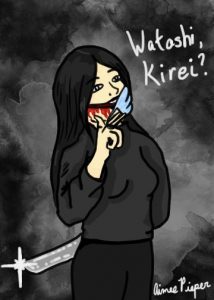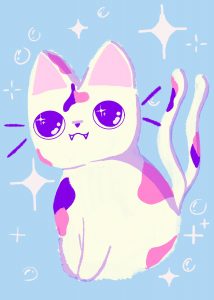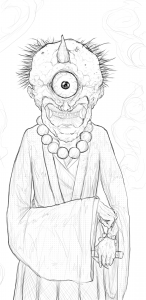Dr. Laura Miller, Ei’ichi Shibusawa-Seigo Arai Endowed Professor of Japanese Studies and Professor of History, recently held a contest for students, sponsored by the Japanese studies professorship.
The objective: draw a yōkai and tell us about it.
Yōkai are cute, creepy, humorous, and bizarre. Yōkai goblins and ghosts have populated Japanese folklore and popular culture for centuries, from the woodblock Night Parade of a Hundred Demons by Toriyama Sekien (1776) to the manga Kitarō of the Graveyard by Mizuki Shigeru (1960). There’s even one that can stave off epidemics and COVID 19 named Amabie. Try your hand at drawing one of the many of types of yōkai, including Kappa, Tanuki, Tengu, Futakuchi Onna, Rokurokubi, Hitotsume Kozō, and more!
Winners were selected by the following panel of acclaimed scholars of the Japanese supernatural:
Dr. Michael Bathgate (Saint Xavier University), The Fox’s Craft in Japanese Religion and Culture: Shapeshifters, Transformations, and Duplicities
Dr. Rebecca Copeland (Washington University), In Search of the Japanese Mountain Witch: Yamamba
Dr. Noriko Reider (Miami University), Japanese Demon Lore: Oni from Ancient Times to the Present
And now, without further ado, the winners:
First place: Kuchsake Onna by Aimee Pieper

I chose to draw Kuchisake Onna for the Yōkai Contest because ever since I learned about Kuchisake Onna she has haunted me with her horrific tale of face mutilation and pointless questions. There is something so terrifying about being helpless in a social situation, where both positive and negative answers to a stranger’s questions end in mutilation or murder. You have to be clever to escape her, and I’m not sure many of us could accomplish this today. In addition, the mandate for masks today makes Kuchisake Onna more real and terrifying. She is often described as wearing a surgical mask in the tales told of her, which makes it all the more possible that she is blending in with the masked crowd, hunting for her next victim. You would never know it was her if you passed her on the street. Because who knows what lies under a mask these days?
Note from the judges:
The judges agreed that the drawing by Aimee Pieper, Kuchisake Onna (Slit-Mouthed Woman), created the greatest creep factor. They commented on the dark mood of the drawing, its nice visual composition, and how well it resonated with the contemporary moment. They appreciated the way that Aimee reflected on this yōkai as well. As Dr. Bathgate noted “I particularly liked the narrative accompanying the drawing and the way the artist tied the Kuchisake Onna to our contemporary situation.”
Second place: Nekomata by Anna Bakowski

I have drawn a nekomata, a classic Yōkai that is a two-tailed cat. Nekomata folklore says that when cats grow old, they grow a second tail and go to live in the mountains. Nekomata were believed to be malicious spirits that could raise the dead and control them. Since its inception in the Kamakura period, depictions of the nekomata have given it a much softer image. I have drawn a cuter, colorful take on this classic Japanese Monster.
Third place: The Shunobon by Sam Choi

The Shunobon (朱の盆) are one-eyed demons donning a large head with crimson skin, prickly hair, a horn, and a menacing ear-to-ear grimace. Dressed in priest garbs, these nefarious spirits lurk in the mountains and villages of Niigata, typically appearing in the dusk of night. Its ghastly visage is said to frighten even the most steadfast of hearts, sometimes to their death. Striking fear in the hearts of locals, the legends of the Shunobon would deter the timid from setting foot in empty roads and alleys alone.
Thanks to all who entered!
